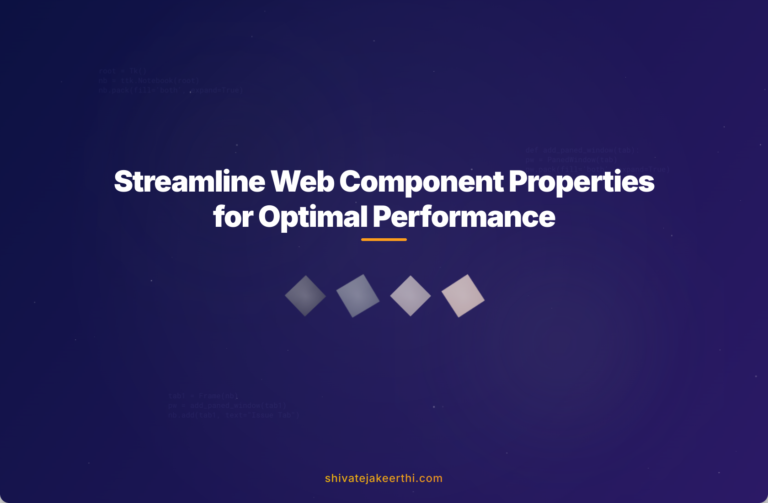Using Web Components has become increasingly popular in web development because they offer reusable, encapsulated modules independent of any external frameworks. They simplify creating consistent user interfaces across applications and teams. However, developers often face challenges when dealing with their property assignment and rendering, especially regarding the component lifecycle.
A common struggle arises from confusion between attributes and properties in web components. Let’s clear this confusion and establish best recommendations for setting properties during web component development to ensure proper rendering.
Understanding Attributes and Properties in Web Components
When you’re working with web components, it’s essential to distinguish clearly between attributes and properties, as each serves a unique role in your web application’s behavior.
Attributes: Simple Text-Based Data
Attributes represent simple text-based information in your HTML tags, similar to how you’d use a standard HTML tag. They’re commonly used for passing string-based variables.
For example:
<custom-button label="Submit"></custom-button>Here, “label” is an attribute defined directly in HTML markup. Attributes are useful when you need to pass in simple strings or numbers and don’t require complex types.
Properties: Handling Complex Data Structures
Properties, however, let you pass complex JavaScript objects, arrays, functions, or even other web components. Unlike attributes, properties aren’t directly reflected or readable from HTML mark-up and thus need extra consideration.
Properties often require JavaScript’s getter and setter methods to properly manage and respond to changes in the associated values. They play an important role in ensuring your web components maintain consistency during runtime interaction.
For instance:
myElement.data = { name: "John Doe", age: 30 }This line sets a “data” property directly through JavaScript, enabling your component to meta-manage rich, complex data efficiently.
Lifecycle Methods: connectedCallback and Its Role
In web components, various lifecycle methods guide your element from creation to destruction. One central lifecycle method is connectedCallback(). This method activates when your element inserts into the actual document object model (DOM).
This timing is crucial because it’s your signal that the element is part of the DOM and ready to render properly. It’s the ideal spot for initializing your component’s content or interacting with the DOM directly.
Case Study: Setting Properties for Parent and Child Components
Consider building two components: a parent-element and a nested child-element. Your parent component holds a property that it passes down to a nested child component. Let’s walk through designing these components step-by-step.
Parent Component Design and Implementation
The parent-element defines a property via getters and setters, ensuring our data is managed and updated correctly:
class ParentElement extends HTMLElement {
set user(value) {
this._user = value;
this.render();
}
get user() {
return this._user;
}
render() {
this.innerHTML = `
<child-element></child-element>
`;
this.querySelector("child-element").data = this._user;
}
connectedCallback() {
if (!this._user) {
this.render();
}
}
}
customElements.define('parent-element', ParentElement);
This structure maintains correct rendering by ensuring property assignment triggers component updates.
Child Component Implementation
The child-element component receives a ‘data’ property and utilizes it for rendering content directly:
class ChildElement extends HTMLElement {
set data(value) {
this._data = value;
this.render();
}
get data() {
return this._data;
}
render() {
this.innerHTML = `
<p>User: ${this._data.name}, Age: ${this._data.age}</p>
`;
}
}
customElements.define('child-element', ChildElement);
Testing Proper Property Assignment and Rendering
When creating instances of your components and assigning properties, consider different sequences and observe their effects:
const parent = document.createElement('parent-element');
parent.user = { name: "Jane Doe", age: 25 };
document.body.appendChild(parent);
Setting the “user” property before appending ensures the connectedCallback is triggered with data already available, promoting immediate correct rendering.
However, what happens if you set the property after appending to the DOM?
const parent = document.createElement('parent-element');
document.body.appendChild(parent);
parent.user = { name: "Jane Doe", age: 25 };
The second scenario causes an initial render call without proper data, temporarily showing missing or partial content until the property assignment refreshes the component.
Analyzing Rendering Issues and Questions
Let’s explore common questions surrounding these behaviors:
- Why does the second rendering sometimes appear without text? Due to the property value being updated after the DOM insertion and connectedCallback trigger, the initial render call is done without proper data, causing content to appear blank initially.
- How does text appear instantly in the first scenario without explicitly calling setters internally? Since the properties were pre-assigned, connectedCallback renders already-populated properties, displaying complete content immediately.
- Why is calling appendChild() before property assignment not ideal? Appending before property assignment extends the rendering process unnecessarily, causing initial “flash” of incomplete content and negatively affecting user experience.
- What’s the best time to call render()? Ideally, render components only after properties affecting user-visible content have been set to ensure smooth user interactions and minimal “blinking” or incomplete content.
By clearly understanding this behavior with hands-on examples, you reliably achieve efficient rendering and enhanced user experience.
Best Practices for Setting Properties and Rendering Components
Here are some simple guidelines to optimize the rendering behavior of your web components:
- Always define getter and setter methods clearly for managing component properties.
- Set necessary properties before appending components to the DOM to avoid unnecessary re-renders.
- Make your connectedCallback simple and focused—perform rendering tasks here only if data is available and necessary for initial rendering.
- Regularly validate your web components’ rendering flow through logging and debugging techniques to detect and rectify issues early.
- Consider performance optimization strategies such as DOM batching or rendering content conditionally.
Following these practices drastically reduces common pitfalls developers encounter in web component lifecycles, optimizing performance significantly.
Often, rendering difficulties are frustrating, yet simple property assignment adjustments can deliver impactful improvements in your web components’ performance. There’s always more to learn and refine—what issues have you encountered in working with web component lifecycles, and how did you overcome them? Share your thoughts and experiences—I’d appreciate hearing your feedback!



0 Comments